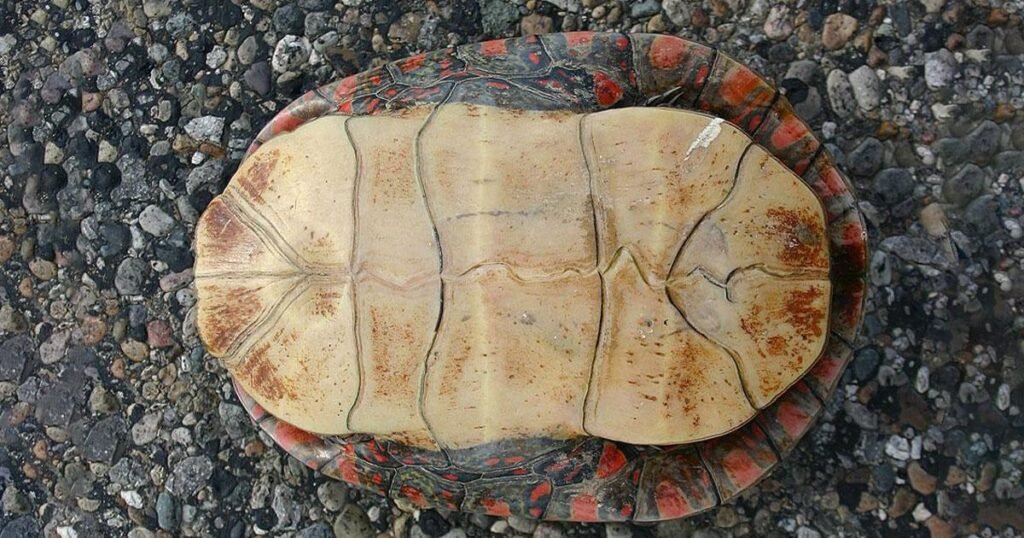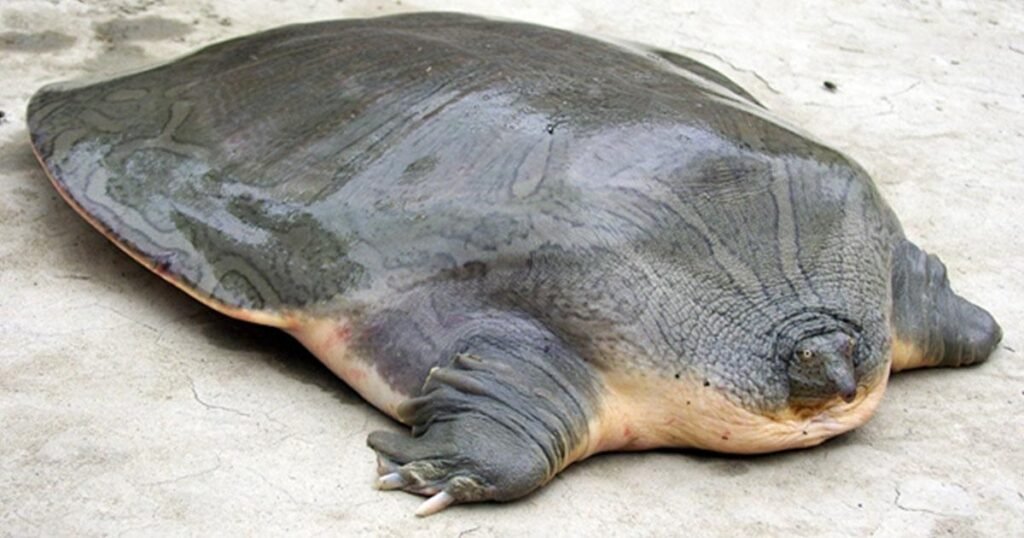Imagine what does a turtle without a shell look like? Doesn’t it sound weird? To a turtle, its shell is like its home, its shield, and its super cool superhero cape! But what if we could take a quick look through that armor to see what’s inside?
Turtles are very common animals that live in the world, and you can find them in a lot of different places. If you look at their shells, you can divide them into four groups: tortoises, terrapins, soft-shelled turtles, and hard-shelled turtles. They all lose their shells when they grow up, which is something they all have in common. In this article, we will discuss what does a turtle look like without a shell. Come with us on this trip as we try to solve the puzzle and find out more about these interesting creatures.
Table of Contents
The Shell: A Turtle’s Home and Armor

A turtle’s shell isn’t just a fancy decoration; it’s like a built-in house and shield. It is an important part of a turtle’s body because the top part called the carapace, and the bottom part, called the plastron, are fused to the spine. Imagine if we had our ribs permanently connected to a protective backpack – that’s kind of like a turtle’s shell!
Turtles are reptiles, and like all lizards, they have a backbone, scales, and lay eggs. A turtle without a shell meaning is actually part of a turtle’s skeleton, made from modified ribs and vertebrae. The bony plates are covered by a layer of keratin, the same protein found in human hair and nails. This combination provides a tough and resilient structure that protects the turtle from harm.
What Does A Turtle Without A Shell Look Like?

Ready for a turtle talk? Do you wonder about the Turtle without a shell meaning? Ever thought about what a turtle without a shell looks like? It’s a bit like picturing a superhero without a cape – interesting, right?
Okay, let’s use our imaginative eyes. Imagine a turtle without shell would look like a turtle in its jammies! The shell is like their cozy, protected blanket, so without it, their skin would be out there, saying, “Hello, world!”
You’d see their head, legs, and tail, all wiggling and moving. Turtles come in different colors and patterns, so their skin could be smooth and shiny or have cool designs. It’s like finding a whole new side of their turtle style.
But here’s the big secret: Turtles are like real-life superheroes, and their shells are their super suits. Without the shell, they wouldn’t be as strong and safe. The shell is their home, sweet home, keeping them safe from bad guys (or, you know, other animals that might want to play rough).
So, while picturing a turtle without a shell is fun, let’s be thankful for the amazing super suits that make them the awesome turtles we know and love. Keep being curious, and who knows what other cool turtle facts you’ll discover!
Ways To Assist A Turtle Without A Shell
A turtle without a shell is a sad sight. Fortunately, there are ways to help these turtles get back on their feet. Here are four tips:
- Stay Calm and Gentle: If you ever come across a turtle without a shell, the first thing to do is stay calm and be gentle. Turtles can get scared, so approach them slowly and quietly.
- Call for Help: Turtles need pros to take care of them. Ask an adult to call a nearby animal rescue or wildlife center. They have superhero vets who know exactly how to help turtles in need.
- Keep a Safe Distance: Turtles might be feeling a bit frail without their shells, so it’s important to give them some space. Stand back and let the pros do their thing.
- Create a Safe Spot: If the turtle is in danger, like on a busy road, you can carefully move it to a safer place. Use a gentle touch and guide it in the direction it was going.
- Don’t Feed Them: Turtles have special diets, and it’s best to leave the feeding to the pros. Avoid giving them any food, as it might not be good for them.
- Spread the Word: You can be a turtle hero by sharing the word about helping turtles. Tell your friends, family, and classmates about the value of protecting these incredible creatures.
- Learn More About Turtles: The more you know, the more you can help! Read books, watch movies, and ask questions about turtles. Understanding them better will make you a true turtle winner.
- Join Conservation Efforts: There are awesome groups and projects committed to saving turtles and their habitats. You can join or support these attempts to make a big difference.
The Distinction Between a Healthy and an Unhealthy Turtle
If you’ve never seen a turtle without its shell, you’re in for a treat. Healthy turtles usually have smooth, unblemished skin that is free of bumps or lesions. An unhealthy turtle, on the other hand, may have a bumpy shell or areas of scaly skin. In severe cases, an unhealthy turtle may even have open sores on its shell or body.
There are several reasons why a turtle may grow an unhealthy appearance. Some turtles get sick very often and their immune systems can’t keep up with the infection attack. Other turtles may be abused or ignored and their delicate skin may become damaged from constant contact with water and dirt.
Whatever the cause, it’s important to take action if you see your turtle looking sick. A healthy turtle can live up to 50 years, so there’s plenty of time to help it recover. If you think your turtle is in trouble, bring it to a doctor for evaluation.
Read More: Turtle Shell Fungus: Causes and Essential Care
Can A Turtle Be Born Without A Shell?
If you think a turtle without a shell is an odd sight, you’re not alone. Most people don’t believe that it can happen, but it does! Some turtle species are born with just a thin layer of skin covering their bones.
Other turtle species don’t have shells at all! This is the leatherback turtle (Dermochelys coriacea), which is the biggest living turtle and can weigh up to two hundred and fifty pounds.
Most turtles that are born without shells do so in the wild because their mother doesn’t have time to protect them from predators. But in some cases, baby turtles with thin shells are purposely bred by people who want to keep them as pets.
Read More: Can a Turtle Live Without a Shell?
FAQs
Can a turtle take off its shell?
Nope! A turtle’s shell isn’t like a removable bag. It’s actually fused to their spine, making it as much a part of them as our bones are to us. Imagine having your ribs permanently connected to a protective shield – that’s kind of like a turtle’s shell!
What do turtles look like without a shell?
Not pretty, sadly! Their exposed flesh would be subject to predators, dehydration, and injuries. Without its shell, a turtle wouldn’t live for long in the wild. It’d be like us walking around without skin – ouch!
Are there any turtles with special shells?
Absolutely! Nature loves getting creative with turtle shells. The leatherback sea turtle has a shell made of thick, leathery skin instead of bone, great for riding ocean waves. And the softshell turtle has a flexible, pancake-like shell that lets it dig into mud like a sneaky ninja!
What’s inside a turtle’s shell?
Think of it as a nice turtle apartment! Their heart, lungs, stomach, and other parts are tucked away safely inside, like furniture under a roof. They also have strong muscles for retracting their head, limbs, and tail into the shell for extra safety.
How can we help turtles?
These shell-tastic friends deserve our respect and care! Never try to hurt them or remove their shells. Remember, their shells are important for their survival. We can help by keeping waterways clean, avoiding littering, and backing conservation efforts.
Conclusion
Our adventure into the world of turtles without shells has taken us on a fascinating trip of discovery. While it’s fun to let our imaginations roam, it’s important to understand the vital role that shells play in a turtle’s life. As we continue to explore the wonders of the natural world, let’s remember to respect and protect these amazing creatures and their habitats. Together, we can ensure a world where turtles survive and continue to captivate our curiosity for generations to come.
